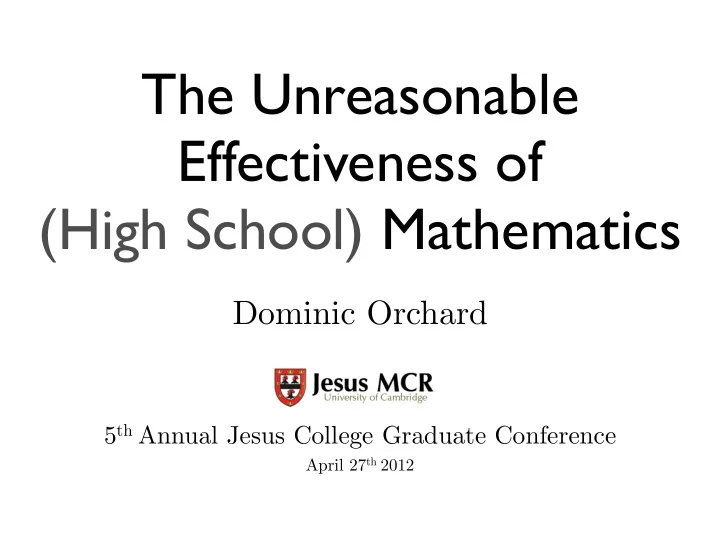

The Unreasonable Effectiveness of (High School) Mathematics Dominic Orchard 5 th Annual Jesus College Graduate Conference April 27 th 2012
Some sums... (elementary school!) 2 + 2 = 4 1 + 0 = 1 0 + 3 = 3 0 + 0 = 0
... with variables (high school) x + 0 = x 0 + x = x
... with three numbers 3 + 4 + 2 = 9 6 + 1 + 4 = 11 How did you do it?
Reducing “pairs” 6 + 1 + 4 6 + 1 + 4 ( ) ( ) = 6 + 5 = 7 + 4 = 11 = 11
Some axioms of + 0 does nothing (with respect to + ) x + 0 = x 0 + x = x grouping into pairs doesn’t change result ( x + y ) + z = x + ( y + z )
Some more sums... 2 × 2 = 4 3 × 4 = 12 1 × 3 = 3 4 × 1 = 4
... with variables x × 1 = x 1 × x = x
Reducing “pairs” ( ) ( ) 2 × 3 × 4 2 × 3 × 4 = 6 × 4 = 2 × 12 = 24 = 24
Some axioms of × 1 does nothing (with respect to × ) x × 1 = x 1 × x = x grouping into pairs doesn’t change result ( x × y ) × z = x × ( y × z )
Axioms of × and + x + 0 = x x × 1 = x 0 + x = x 1 × x = x ( x × y ) × z = x × ( y × z ) ( x + y ) + z = x + ( y + z ) x × y = y × x ( ) x + y = y + x
Common structure... monoids Not the Dr. Who aliens with one eye.....
Monoids • A collection of things X e.g. (whole) numbers • An operation that turns two X s into one X ⊕ e.g. + or × • A special X , call it n, that does “nothing” with ⊕ e.g. 0 (for + ) or 1 (for × ) = { right unit } x ⊕ n x = { left unit } n ⊕ x x ( x ⊕ y ) ⊕ z = x ⊕ ( y ⊕ z ) { associativity }
* Unreasonably effective • Monoids are a simple (abstract) concept (cf. counting*) • Extremely ubiquitous • Computer Science • • Logic Maths • • Linguistics (semantics) Physics • • Everyday phenomena Topology * The Unreasonable Effectiveness of Mathematics (R. W. HAMMING, 1980)
Not trivially effective • Plenty of things are not monoids 3 - 0 = 3 ✔ 0 - 3 = -3 ✘ (2 - 3) - 4 = -5 ✘ 2 - (3 - 4) = 3 • Interesting to study the things that are not
New example: Paint mixing! ⊕
Paint-mixing • Collection of “things” X Acrylic paints • Operation that turns two X s into one X ⊕ = • Special X that does “nothing” with ⊕ n = “ Extender” base
Monoids of “containment” • means take two containers where one ⊕ is inside the other, and flatten into one: 1 = 1 ⊕ 2 2
Monoids of “containment” • “Nothing” (trivial) container, n = x = x x ⊕ = ⊕ x x
Dreams as containers... (idea originally due to Dan Piponi)
(“Containment monoids” usually called monads )
Dreams as container monoid... • Anything can be put into a (trivial) dream n
Dreams as container monoid... • A dream inside a dream is just a dream (collapse) x y x ⊕ ⊕ y
Computations (functions) g A B B C f ⊕ = A C g f ⊕
Computations (functions) x x A B n f ⊕ = A B f
My work.... C B A B g f ⊕ = C A g f ⊕ • Special kinds of monoids for and
Importance of monoidality • Underlying equational theory ... + x + 5 + (-5) + y + ..... Additional property ... + x + 0 + y + ..... Monoidality ... + x + y + .....
= { right unit } x ⊕ n x = { left unit } n ⊕ x x ( x ⊕ y ) ⊕ z = x ⊕ ( y ⊕ z ) { associativity } • Monoids pervasive (many more examples) • Unreasonably effective but very simple • My work: more complex models of computation with underlying monoid properties: Thanks! dorchard.co.uk
Back-up slides
Computations (functions) C A B B g C D f h ⊕ ⊕ = A C D C f g h ⊕ ⊕ = A C g f ⊕ h ( ) ⊕
Computations (functions) C A B B g C D f h ⊕ ⊕ = B A B C g f h ⊕ ⊕ = A C g f ( ) h ⊕ ⊕
Non-deterministic Computations • Previously, output single result A B f • Non-deterministic: output many possible results B* A f
Non-deterministic Computations C* B* ? g B A f ⊕ = C* A f ⊕ * g
Non-deterministic Computations C* B* B* g * A f ⊕ = C* A * f ⊕ g
Non-deterministic Computations • Need to design the * operation and a “nothing” computation id* to satisfy monoid axioms e.g.: ? * B* A* ? * f id* ⊕ B* A f =
Recommend
More recommend